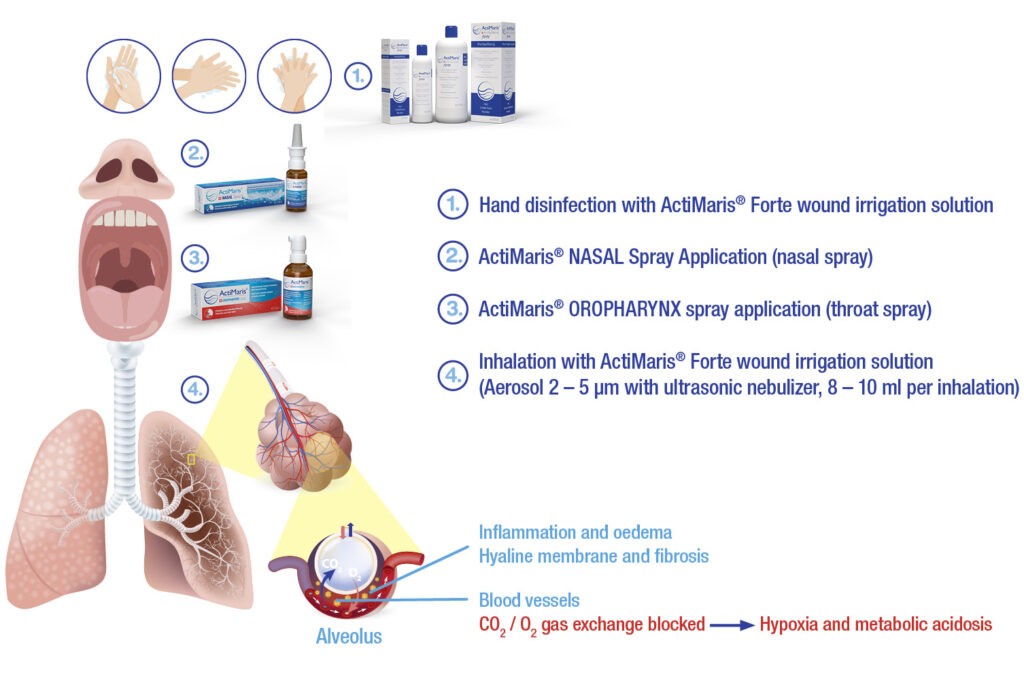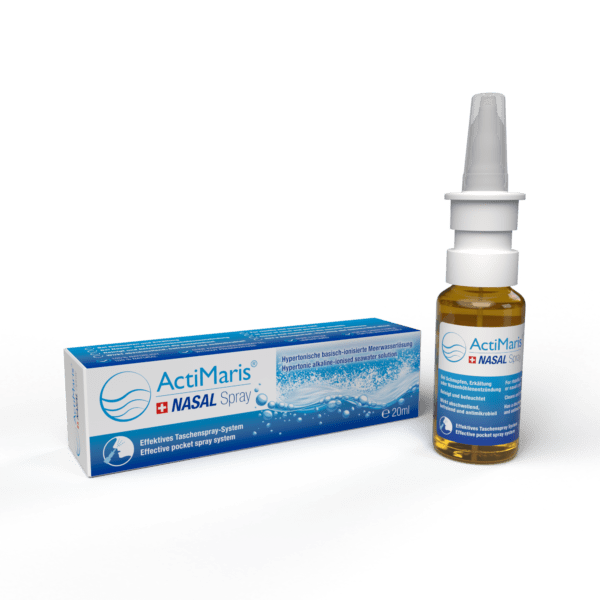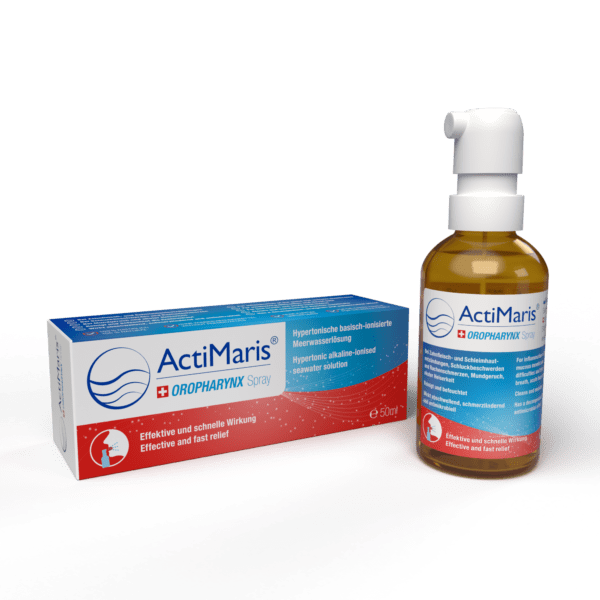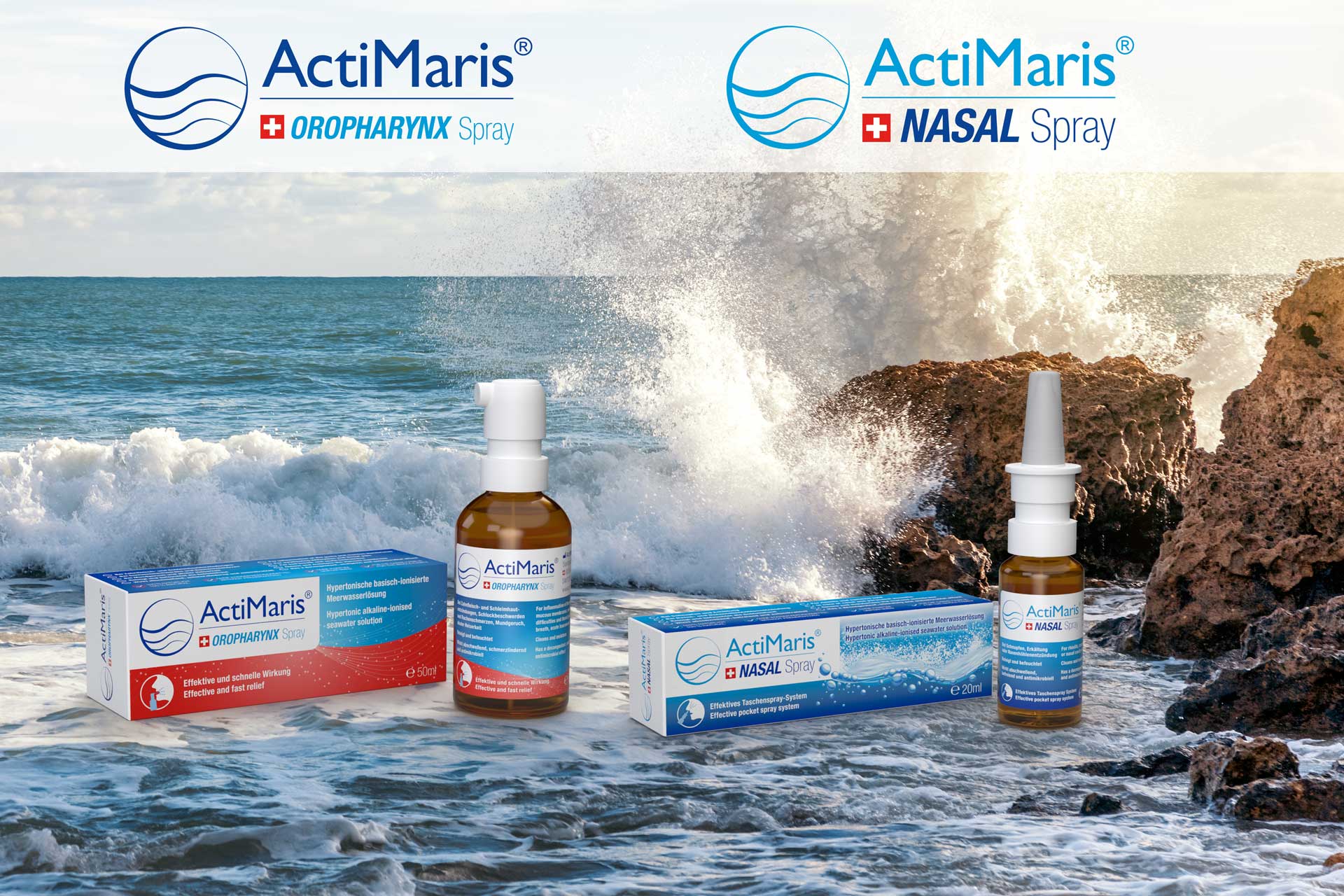
Nasal spray and throat spray from ActiMaris®
The allrounder duo from the sea for all 4 seasons




Why an ActiMaris® nasal spray and throat spray?
The sea is not just the source of life, it is life itself. The sea is also the source of the ActiMaris® products, activated by the process, similar to the phenomenon of the sea surf.
Our body is a sea water aquarium with the redox code, our cells are a sack of sea water with energy quanta (ATP) and the ActiMaris® complex is a sea water drop with a grain of salt and active oxygen (ROS).
The composition and the ratio of the minerals, salts and trace elements in sea water is similar / identical to that in our blood serum, with the same osmolarity of 300 mOsm/l. These facts are also reflected in the ActiMaris slogan: “simple medical solutions, designed by nature”.
All this makes ActiMaris® Solution and Gel the ideal local therapeutic for infectious inflammatory and damaged tissue (wound), as ActiMaris® transforms the pathological environment of the tissue into the physiological, the first precondition for the initiation of the healing process.
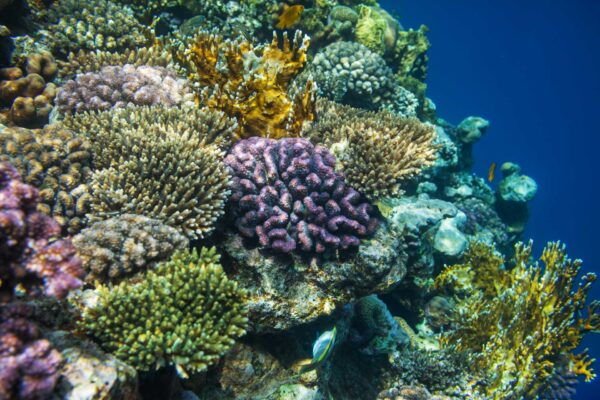

The sea is like a secret pharmacy, and research into medicines from the sea is constantly increasing in intensity. Sea sponges, algae and micro-algae have already yielded some bio-active substances/natural materials, including some with antimicrobial properties. Coral reefs are at the same time a good example of the destruction of the natural environment, the process that can lead to the dying off of the coral population through the acidification of sea water and the disruption of the healing process.
The allrounder duo from the sea for all 4 seasons
Autumn and winter months are the season of colds, flu and other viral infections, as well as bacterial infections and inflammatory processes in the upper and lower airways. It is also important to note that many bacteria (S. aureus around 33%) and viruses (flu viruses, coronaviruses, rhinoviruses – around 15%) live peacefully as commensal bacteria on the mucous membrane inside the nose (in the process of amphibiosis). Especially with the increased virulence of the pathogen and the weakened immune system of the host, our “roommates” can become pathogenic and cause the infections/diseases.
Spring and summer months are the time of seasonal allergic reactions/sicknesses in the upper and lower airways, sometimes with severe symptoms and social restrictions. Allergic skin reactions and sensitivities are also more frequent in the summer months. ActiMaris® Sprays reduce and block the allergic skin and mucous membrane reaction by reducing the release of histamine and of interleukins from the mastocytes. The hypertonic, ionised sea water solutions with active oxygen and oxylchlorite are an ideal solution for the mucous membrane as well as for prophylactic and therapeutic measures in the ENT area.
ACTIMARIS® NASAL AND OROPHARYNX SPRAY
CAN A FEW SPRAYS A DAY KEEP THE DOCTOR AWAY?
For people who can look further than the tip of their nose, the high potential of the nasal and oropharyngeal see salt solution combined with reactive oxygen species is easily recognisable.
This is supported by the results of evidence-based medicine (EBM) from basic and clinical research, both our own and from many studies (literature), which confirm this.
THE OTHER AND SUCCESSFUL CONCEPT (PARADIGM SHIFT) OF MUCOUS MEMBRANE CARE, PROPHYLAXIS AND TREATMENT OF THE INFLAMMATORY AND INFECTIOUS PROCESSES IN THE ENT AREA AND THE UPPER AND LOWER RESPIRATORY TRACT
An overview
Traditionally, the eyes are viewed as the external “window into the body”, because opthalmologic “changes” reflect the systemic condition of the body.
In the same way, there is an mutual interaction between the nose and the rest of the body. And one can speak of the nasal manifestations of systemic illnesses.
The nose is the most prominent part of the face and has an immensely important protective function, not just for the upper respiratory tract but also for the lower one. Unfortunately, in the ages of “beauty craze” the nose, due to its prominence, is reduced to a beauty object/structure. But in addition to lending a characteristic expression to our physiognomy, the nose is an important component of the respiratory system and is also a smell organ. Through its exquisite regulative function of cleaning/filtering, warming and humidifying the air we breathe in, it protects the lower airways, bronchi/lungs from infectious, toxic and immunologically harmful particles and substances.
Below is an example of the relation and mutual interaction between the nose and the rest of the body, illnesses and medication therapy:
- Chronic sinusitis, allergy and asthma
- Nasal polyposis and systemic diseases
- Rhinitis, nasopharynx and middle ear diseases
- Systemic manifestations of medication therapy for rhino-sinusitis
- Effects of the systemic medication therapy on the nasal mucous membrane
- Rhino-sinusitis and headaches
- Sinus-induced dizziness
The structure and function of the respiratory epithelium of the upper and lower airways are very similar. That is why one also refers to “united airways” and “one way, one disease”.
For these reasons, it frequently happens that a prolonged inflammation in the upper airways (nose/rhinitis) spreads to the lower airways (bronchitis) (vegetative-nasal/nasal-pulmonary reflex). One also speaks of the post-nasal drip syndrome (PNDS) or sino-bronchial syndrome. Another frequent occurrence is the spread of the inflammatory process from the inside of the nose to the sinuses, especially when these are poorly ventilated. This is then called rhino-sinusitis.
A blocked nose or rhinitis hyperplastica can also impede the function of the auditory tubes/Eustachian tubes, resulting in a ventilation disruption of the middle ear and the formation of a middle ear effusion ex vacuo, especially in children, but also in bacterial middle ear infections.
A blocked nose also reduces the ability to smell. In the case of more severe virosis, such as influenza or corona infection, reversible or even irreversible loss of smell can occur. A relevant sensory disorder is associated with the loss of quality of life, a situation which is also allegorically reflected in the saying “I cannot smell you”. At the same time, the peripheral olfactory organ at the top of the nose (anterior base of the skull) is coupled with the limbic system, the emotive and associative system, and consequently it can trigger emotions and “flashbacks”.
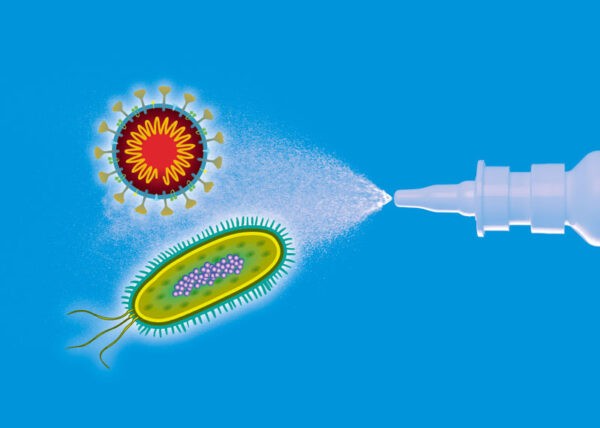
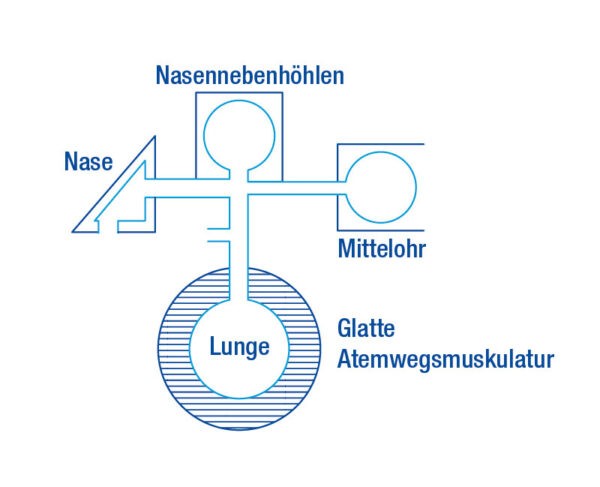
For these reasons, it is very important to initiate early/prophylactic treatment of acute rhinitis/cold to prevent sinusitis and/or bronchitis as well as secondary bacterial infections.
At rest, an adult breathes in and out around 10,000 litres of air. Over his lifespan, a person breathes in and out some 7 billion times. This is also why the inside of the nose and the upper airways are colonised/contaminated by many viruses and bacteria and why the nose especially acts as a sentry and protector of the lower airways. This is also why prophylactic treatment of infections in the upper and lower airways with a physical-chemical conceived medical products like ActiMaris® in the form of a nasal and throat spray is very important.
Humans were designed by nature to be “nose-breathers”. ActiMaris® products are also “designed by nature” and there is a strong connection between the dynamic molecular reciprocity and compatibility between the inhaled oxygen gas in the lung and physically dissolved oxygen in the tissue/cell and in the ActiMaris® solution when fighting infectious processes in the mucous membrane and skin.
98 % of the body’s oxygen supply is provided by the respiratory system / nasal lung and 2 % by the intact skin. The same is also conceivable for the endonasal mucosa. With intact skin, atmospheric oxygen (O2) penetrates to a depth of about 0.4 mm (to the upper dermis); with an epidermal lesion / wound, even deeper. Physically dissolved oxygen in ActiMaris® solution and gel (> 100 ppm) corrects the hypoxia in the tissue and the oxygen as an energy source brings all missing parts back together and supports the healing processes.
The dust particles and microbes are locked in the nasal cavity and sinuses when inhaling and are caught by the mucous layer. This mucous layer is constantly renewed, and mucociliary clearance mechanisms move it to the throat area, where it is swallowed, but it is also renewed through the act of mucophagia. The respiratory system is a well-balanced system, and everyone notices when it is disrupted by excessive mucous production, swollen mucous membranes, nasal polyps or foreign particles. When one becomes aware of one’s breathing (due to a blocked nose), it is very probably because something is wrong and one is thinking of going to the doctor. Or if there is no pain and fever, apply a local treatment of the blocked sinuses with ActiMaris® Spray for a couple of days. The effect of the activated sea water solution inside the nose is mainly a physical one. The sea salt solution removes the excess mucous and improves mucociliary clearance. The sea salts, minerals and trace elements in the sea water have additional benefits, especially after the energetic activation and in combination with the oxygen and oxychlorite. With its hypertonic saline solution and hyper-osmolarity, the ActiMaris® complex has a decongestant effect on the mucous membrane, but without the “rebound” effect, and frees the nose for breathing. The regular application of sea salt/ROS solution/sprays can reduce the number of viral and bacterial infections and prevent the drying out of the mucous membrane as well as contribute to maintaining the natural defence mechanisms.
Colds are the most common infections in humans by far. Adults get sick on average 2-3 times per year, small children up to 10-13 times. Germans (around 83 million inhabitants) spend some 1.5 billion euros on cold medication every year. Of this, around a third (some 500 million euros) is for nasal and throat sprays. Around 70 million Germans use a nasal spray for a runny nose. According to the same statistic, 500,000 to 1 million Germans are addicted to nasal sprays of the sympathomimetic type. These should not be taken for longer than 7 days and should not be applied frequently, as they can result in “rebound rhinitis” due to their damaging the ciliated epithelium, and they are also addictive. In all inflammatory processes of the mucous membrane of the upper (as well as lower) airways, the self-cleaning function, the function of the ciliated epithelium, is disrupted.
Sympathomimetic drugs in nasal spays get their decongestive effect by stimulating α-receptors, resulting in the constriction of the blood vessels in the nose. But because they also stimulate β-receptors, which trigger vessel expansion, if they are used for a longer period they produce a swelling of the mucous membrane through the “rebound” effect. Preservatives (benzalkonium chloride) in nasal sprays further increase the damage to the mucous membrane. With prolonged, repeated colds, a secondary rhino-sinusitis and pharyngo-laryngitis, as well as bronchitis, are common. For instance, in the USA every fifth antibiotic prescription is for rhino-sinusitis. There are close to 2,000 clinical studies indicating that antibiotics have no benefits compared to a purely symptomatic treatment in uncomplicated acute rhino-sinusitis. In these cases, “watchful waiting” should be applied, also to avoid the risk of creating resistance in bacteria. For acute or chronic non-allergic rhino-sinusitis, nasal sprays containing cortisol are only somewhat indicated, if at all. Most nasal sprays based on sea salt (or table salt) are isotonic (0.9%) solutions and only have a cleansing effect. For a few years now there have also been some nasal sprays with a sea salt concentration of 2.3%, which decongest via the osmotic effect. But no more than that! Until now, there was no universal “allrounder” nasal spray and mouth/throat spray for a longer-lasting prophylactic and therapeutic local application, especially one without side effects and counter-indications. And it is well known that both the sympathomimetic and the corticosteroid sprays are associated with many shortcomings, side effects and counter-indications.
ActiMaris® represents a new milestone in the treatment concept of local therapy for inflammations and infections of the upper and lower airways (for the composition and mechanism of action see product details) and resulted in a paradigm shift in the treatment concept, not just in the area of the mucous membrane but also of the skin and for burns, acute and chronic wounds (see literature und publications) .
ActiMaris® can be applied ubiquitously both as prophylaxis and therapeutically for as long as necessary, from infants to old age, without side effects, interactions and counter-indications.
ActiMaris® has a cleaning and nurturing effect on the mucous membrane, humidifies it, reduces swelling, removes mucous, is antibacterial, supports the local defence mechanisms and promotes granulation and epithelialisation processes in mucous membrane lesions.
ActiMaris® as a gel, rinse solution and spray, as a bioactive redox-signalling treatment, has a much broader range of effects, and consequently ActiMaris® shows clinical benefits as a local monotherapy and/or adjuvant therapy for inflammatory infectious processes of the mucous membrane (but also of the skin), without side effects and with a broad indication spectrum as well as a positive cost-benefit effect (see publications).
Indications for ActiMaris® NASAL Spray (1.2% sea salt), OROPHARYNX Spray (3.0% sea salt) and Wound Gel (3.0% sea salt).
- Prophylactic mucous membrane care
- Runny nose / cold / rhinitis
- Influenza and other viral infections
- Rhinitis acuta et chronica
- Rhino-Sinusitis acuta et chronica
- Rhinitis medicamentosa following abuse of sympathomimetic nasal sprays
- Allergic rhinitis (including prophylactic)
- Eustachian tube/middle ear inflammation
- Epistaxis / nosebleed (shortens bleeding time according to clinical evidence)
- Post-operative (after nasal or sinus operations) stomatitis / aphtae / gingivitis
- Glossitis and mucositis of the mouth
- Tonsillitis / tonsillo-pharyngitis
- Pharyngitis granularis sicca
- Laryngitis posterior/laryngitis acuta
- Reduces and eliminates bad breath (Halitosis / Foetor ex ore)
Tissue tolerance and biocompatibility
The application of ActiMaris® NASAL Spray and ActiMaris® OROPHARYNX Spray is painless and is also well tolerated by allergy sufferers.
In the case of a strong spray impact (irritation of the nerve trigeminal branches of the mucous membrane) and/or a sensitive mucous membrane, as well as in the case of severe acute inflammation, a burning sensation inside the nose may occur, which calms down in the course of therapy. (Like the burning sensation when you go into the sea with a skin abrasion, which also has a healing effect).
ActiMaris® NASAL Spray
Hypertonic alkaline-ionised seawater solution
Product profile
ActiMaris® NASAL Spray moisturises and cleanses in interactions with the mucous membrane. ActiMaris® NASAL Spray also supports the physiological milieu on the surface of the mucous membrane through its composition of minerals, salts and trace elements.
ActiMaris® NASAL Spray contains:
- no cortisone
- no xylometazoline
- no alcohol
- no antibiotic
ActiMaris® OROPHARYNX Spray
Hypertonic alkaline-ionised seawater solution
Produktprofil
ActiMaris® OROPHARYNX Spray moisturises and cleanses in interactions with the mucous membrane. ActiMaris® OROPHARYNX Spray also supports the physiological milieu on the surface of the mucous membrane through its composition of minerals, salts and trace elements.
ActiMaris® OROPHARYNX Spray contains:
- no cortisone
- no xylometazoline
- no alcohol
- no antibiotic
